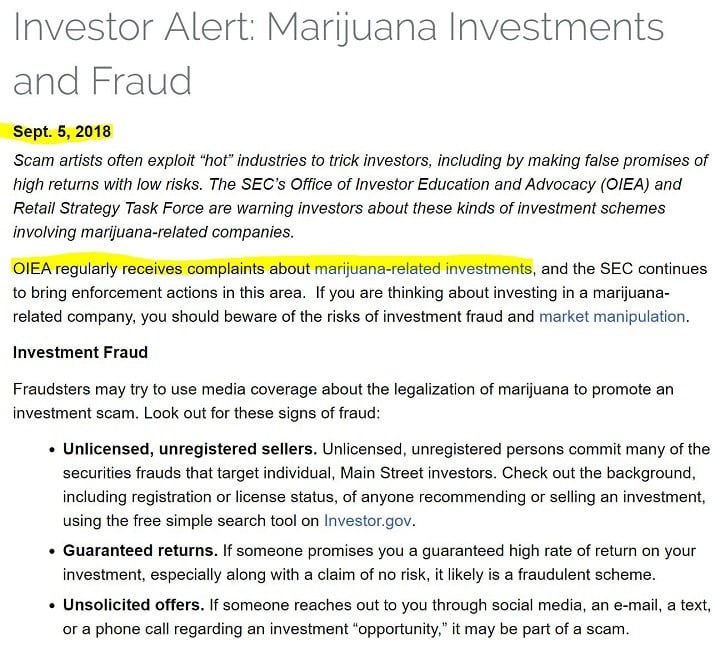The Best Marijuana Penny Stock Doesn’t Exist
Table of contents

Over the past five years we’ve been writing about disruptive technologies – or in the case of marijuana, disruptive investment themes – we’ve moved away from covering over-the-counter (OTC) companies which are commonly referred to as “penny stocks.” To be clear, the one and only reason we ever “covered” OTC stocks was to warn investors about them. It used to be that some OTC companies approached us asking for “media coverage,” and they stopped doing that real quick once they realized that we were not afraid to find all their red flags and quickly warn investors, instead of fawning all over them like a bunch of sycophants.
The same thing holds true today, and will always hold true. In 99% of cases, we caution investors to avoid OTC companies and penny stocks completely. Any competent investor with the slightest bit of experience will tell you the same thing – never dabble in this space – especially as a newbie investor, which many “marijuana stock investors” are. Oftentimes, when we would write about some of these downright scams – whether the operators of these “companies” were acting with malicious intent or not – their reactions would sometimes be downright scary, ranging from cease-and-desist letters to physical threats. (Do you even lift bro?) Still, we occasionally feel the need to offer up continued warning to retail investors about the dangers of penny stocks, especially marijuana penny stocks. As if a warning from the SEC wasn’t enough:

We’ll say it again, do not invest any of your money in penny stocks, especially marijuana penny stocks.
The Media and Penny Stocks
What doesn’t help the whole situation is when legitimate media sources start talking about a marijuana penny stock in the same breath as they talk about a large pharmaceutical stock that trades on a major exchange like Nasdaq. Here’s an excerpt from an article by the Boston Business Journal a few days ago which talked up the merits of an OTC stock called MariMed:
As of Dec. 7, cannabis consultant MariMed Inc. (OTC: MRMD) had seen its shares increase more than five-fold since Jan. 1 — by 474 percent. The next-biggest stock gainer, biotech Vericel Corp. (Nasdaq: VCEL), saw a 240 percent increase during that time.
Even suggesting that a Nasdaq traded stock and an OTC stock ought to be compared side-by-side is downright irresponsible, especially considering that many people who express interest in “investing in marijuana stocks” are new to the game of investing.
Just looking at these two companies side-by-side, you might be tempted to place them on the same playing field. They’re both the same size, for one. Each sports a market cap of roughly $700 million. (Well, at least they did until MariMed came crashing down over the two days it took to write this article.) But the similarities stop there. Vericel has 10X the revenues that MariMed does. (To be fair, it’s rare that you actually see an OTC company with revenues.) Vericel has been in operation since 1989, while MariMed just “pivoted” into marijuana because their last business focus failed:
MariMed only began focusing exclusively on marijuana last year after trying to develop and license 3D interactive streaming software under the name Worlds Inc.
Then there’s the fact that Vericel actually has legitimate institutions that follow the stock, like Bank of America. When it comes to OTC stocks, most institutional investors won’t touch them with a ten-foot pole, and the main reason for that is OTC companies are loosely regulated and do not have the same reporting requirements as do stocks that trade on major exchanges.
But let’s forget about the merits of MeriMed for now. The article talks about how great it is that a share price soared nearly 500% in one year without warning investors that this might be a red flag.
Past Stock Price Performance
Talking about past share price performance as an indication of future share price performance is wrong, as it implies that stock price movement is correlated to value. The increase or decrease in share price for any given company is not a proxy for value. (This same sort of ignorance is on display when someone says, “Google shares are expensive because they trade at over $1,000 per share.”) In fact, a surge in stock price – even for legitimate companies – is often the sign of a bubble. Here’s a great diagram which shows how a classic bubble takes place, and the emotions that are involved at each stage:
That’s kind of how pump-and-dump works, except there are no institutional investors. That’s because institutional investors – the smart money – will never invest in penny stock junk. Furthermore, the share price for most penny stock pump-and-dumps doesn’t revert to the mean, it slowly approaches zero over time, until the worthless shell is then sold to some other pimps who can try and fleece more ignorant retail investors out of their hard-earned cash. While the price of a company ought to reflect all known information for a company (also called the market efficiency hypothesis), that’s far from the case with almost every penny stock we have ever come across.
Red Flags for a Marijuana Penny Stock
After over a decade of covering penny stocks, we can assure you that this an exercise in futility. Keep in mind that 99% of investors will lose money if they invest in a penny stock because most will inevitably fail. It doesn’t matter at what point in time you buy a penny stock, if you hold it for the long term, the likelihood that you will lose all your money is almost certain. Still, if you want to play Sherlock Holmes and try to find the one or two stocks out of thousands that may actually have the propensity to succeed, and you think you’ve found one, we put together a list of red flags that you can look for when analyzing penny stocks. We’re going to add a few more red flags as follows:
- If some tool reached out to you with a “stock tip” via phone or email
- If the company has some analyst report on their website, scroll to the fine print and see if the analysts were compensated for the report
- If there are a bunch of wankers over on Investors Hub forum talking about how the stock is “going to the moon”
- If there are less than 5 employees in the company
- If the management team has a track record of accomplishing nothing – or if they have been involved in other penny stock failures in the past
- If a meaningful amount of their expenditures goes towards “investor relations”
- The company is issuing shares, left and right, to pay for various services from anyone who has a pulse
These are all red flags that you’ll see with many penny stocks. And the problems go way beyond what you can find out from some simple Google searches. About four years back, the FBI ran an operation that uncovered penny stocks scams. What they found was an elaborate world of kickbacks and shady dealings that goes far more deeper than most people think:
This is where the minuscule number of “legitimate” penny stocks will come forward and complain that it’s “not all penny stocks” and that they’re put in a difficult position because of naysayers like us. Our answer to that is, don’t use shell companies to raise capital when you know – or at least you should know if you’re even the slightest bit competent – that the majority are scams. If you choose to go down this path, then you’re going to get called out for it. If your business was that promising, you could pursue venture capital, private equity, bank financing, or any other number of avenues to raise capital – just like the thousands of startups that do this every year.
Conclusion
The same article we mentioned earlier also offers up additional irresponsible advice, like the below statement:
In the U.S., cannabis companies cannot be publicly traded on major exchanges like the Nasdaq, but can trade their shares over the counter.
That’s completely inaccurate. In the past few months, a whole slew of cannabis companies have been cross-listing from Canada to the United States, companies like Aurora, Tilray, and Cronos Group to name a few. If you’re going to start talking about the merits of some penny stock, don’t make uninformed statements like this one which only serve to lessen your credibility. Whether MariMed has future potential or not, you did them no favors publishing an article like this one.
If you’re looking at investing in the marijuana theme today, do not even consider looking at a marijuana penny stock when there are far too many legitimate options to be had. Stick with the major Canadian growers, or even the world’s biggest cannabis ETF. Even then, expect these stocks to be extremely volatile, and in some cases, massively overvalued. Pay attention to things like profitability, because when all this capital dries up, some companies that are burning through cash will be overextended and forced to raise more capital at less-than-favorable valuations. And most importantly, remember that the majority of marijuana penny stocks are garbage, regardless of past performance. Every competent institutional investor on this planet will tell you that the “best marijuana penny stock” doesn’t actually exist, so why bother looking for it?
Sign up to our newsletter to get more of our great research delivered straight to your inbox!
Nanalyze Weekly includes useful insights written by our team of underpaid MBAs, research on new disruptive technology stocks flying under the radar, and summaries of our recent research. Always 100% free.
















